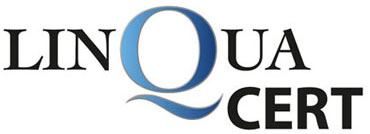Wer kann von LinquaCert zertifiziert werden?
Übersetzungsbüros mit internen und / oder freiberuflichen Übersetzern.
Wie müssen Verfahren und Prozesse beschrieben werden?
Die ISO 17100 besteht aus neun Verfahren, die beschrieben werden müssen. Der Inhalt der Verfahren kann zusammengefasst werden. Die Dokumentation ist abhängig von der Größe des Unternehmens und dem Grad der IT-Unterstützung. Es ist möglich, dass Handbücher in Form von Prosa, Flussdiagrammen und Mind Maps vorliegen.
Welche Verfahren und Prozesse müssen gemäß ISO 17100 beschrieben werden?
- Aufrechterhaltung und Aktualisierung der erforderlichen Kompetenzen (in Bezug auf Übersetzung, Governance, Expertenbewertungen, Bearbeitung).
- Analyse und Bearbeitung von Anfragen, Projektdurchführbarkeit, Angebotserstellung, Abschluss von Verträgen mit Kunden.
- Sprachspezifikationen dokumentieren und weitergeben.
- Projektüberprüfung in Bezug auf die Spezifikationen.
- Buchhaltungs- und Zahlungsprozess.
- Archivierung und Einhaltung aller gesetzlichen und vertraglichen Verpflichtungen.
- Kundenzufriedenheit und Korrekturmaßnahmen.
- Informationssicherheit (Auflistung sensibler Informationen, Analyse potenzieller Risiken, Erstellung eines Aktionsplans) und sichere Speicherung.
- Qualifikationen und Fertigkeiten der Personen für Übersetzungsprojekte.
Sie erreichen uns telefonisch unter +41 44 552 66 19 oder schreiben Sie eine E-Mail an Herrn Markus Kukla, Leiter der Zertifizierungsstelle. Wir freuen uns auf Ihre geschätzte Kontaktaufnahme!
Welche Verfahren müssen gemäß ISO 18587 beschrieben werden?
- Feststellen, ob der Inhalt der Ausgangssprache für MT und die anschließende Nachbearbeitung geeignet ist oder nicht.
- Überprüfung des Endprodukts hinsichtlich der Spezifikationen vor Auslieferung an den Kunden.
- Feedback von Post-Editoren zur Leistung des MT-Systems.
Was ist der Unterschied zwischen Verfahren und Prozess?
Ein Verfahren ist eine Beschreibung, wie einzelne stehende Operationen routinemäßig ausgeführt werden. Der Detaillierungsgrad umfasst Schritte, die Mitarbeiter, Dokumente sowie Hardware und Software umfassen.
Ein Prozess beschreibt, WAS getan wird und das Detail ist ziemlich vage. Prozesse haben Ausgabevariablen definiert, die messbar sind.
Müssen alle Bestellungen gemäß ISO 17100 zur Zertifizierung bearbeitet werden?
Die Zertifizierung bestätigt die Fähigkeit des Unternehmens, Bestellungen gemäß ISO 17100 abzuschließen. Wenn die Erwähnung von ISO 17100 in Marketingmaterialien enthalten ist, geht ein Kunde davon aus, dass Dienstleistungen gemäß ISO 17100 angeboten und verarbeitet werden. Ausnahmen sind möglich und erfordern eine klare Beschreibung in der Vertragsdokumente (z. B. im Angebot oder in der Auftragsbestätigung).
Ist eine ISO 9001-Zertifizierung oder Kundenzufriedenheit zusätzlich zu ISO 17100 sinnvoll?
Die ISO 9001-Zertifizierung kann eine Voraussetzung für den Zugang zu bestimmten Branchen sein. ISO 9001 ist der weltweit anerkannte Standard für Managementsysteme und bei Käufern bekannt. Die Norm basiert auf dem Prinzip der kontinuierlichen Verbesserung und kann mit ISO 9004 kombiniert werden, um wertvolle Synergien zu erzielen. Andererseits sind die formalen Anforderungen der ISO 9001 für reine Übersetzungsdienste nicht erforderlich.
Die Zertifizierung der Kundenzufriedenheit wird Übersetzungsunternehmen empfohlen, die bereits gründliche Umfragen zur Zufriedenheit durchgeführt haben. Mit einer Bewertung für Freundlichkeit, Engagement und Zuverlässigkeit werden Vertriebsaktivitäten durch diese Zertifizierung besonders gut unterstützt, und das Übersetzungsunternehmen kann auch seine einzigartigen Merkmale auf dem Markt glaubwürdig hervorheben.
Wie kompatibel sind ISO 17100 und ISO 18587?
Beide Standards eignen sich gut für eine gemeinsame Zertifizierung. Sie sind strukturell ähnlich und enthalten eine detaillierte Beschreibung der Qualifikationsanforderungen für Übersetzer, Redakteure und Post-Redakteure. ISO 18587 konzentriert sich insbesondere auf die Professionalität der Post-Editoren. Darüber hinaus bilden beide Standards die Vorbereitung, Produktion und Nachbearbeitung auf ähnliche Weise ab.
